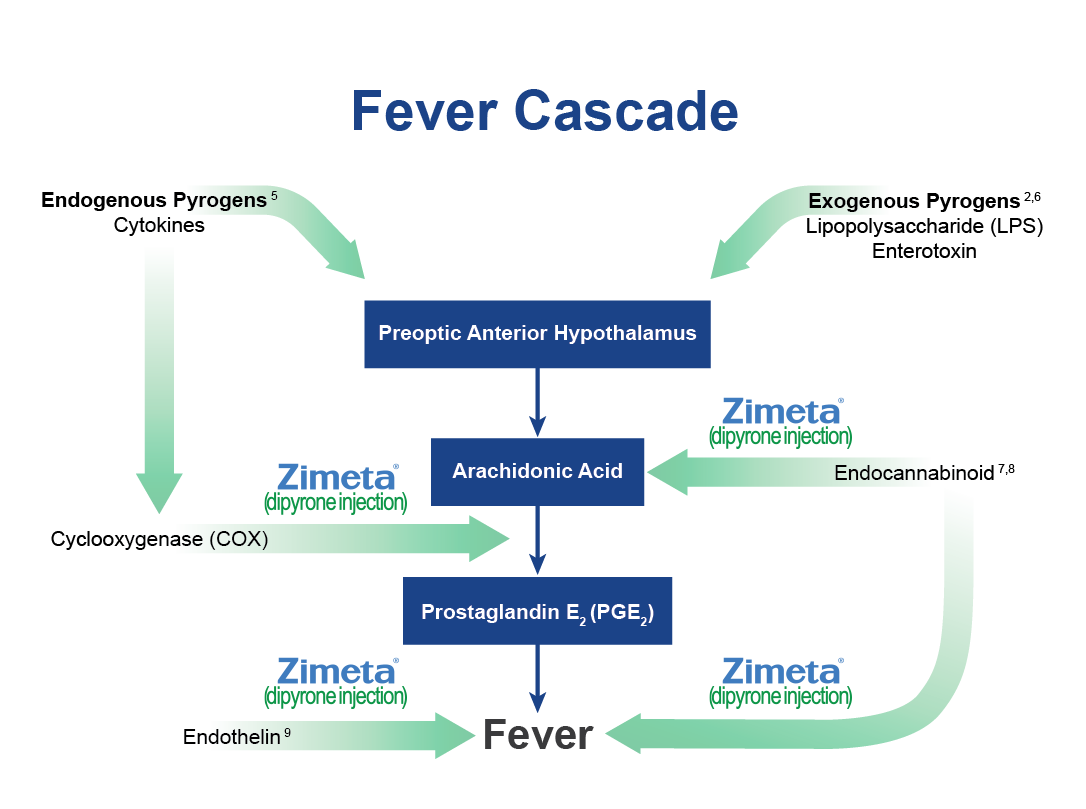ORDER NOW!
Contact your Dechra or Distributor Representative or call (866) 683-0660.
Centrally acting fever reduction
Causes of fever
Both internal (endogenous) or external (exogenous) substances can cause a febrile response in the horse. Most commonly, bacteria and viruses initiate a cascade of events leading to fever. However, neoplastic cells and host-derived antigen antibody complexes also can cause fever.1
Temperature is centrally regulated
After a febrile response is triggered, a complex cascade of events occurs centrally, leading to thermal conservation and an elevated hypothalamic set point. The main pathway to elevation of the hypothalamic set point is through arachidonic acid conversion to prostaglandin E2 (PGE2) catalyzed by cyclo-oxygenase (COX).2,3
Fever is a clinical sign mediated by cytokines, which are short polypeptide segments involved with cell signaling.3 Cytokines are also the mediators of the septic process. When unchecked, pyrogenic cytokines have the potential to be both harmful and beneficial during processes that result in the body generating fever.4
Dipyrone’s mechanism of action
Dipyrone, the active ingredient in Zimeta, is a member of the pyrazolone class of nonsteroidal anti-inflammatory drugs (NSAIDs) and has a centrally acting mechanism of action on the hypothalamus, where fever originates and is regulated.*
There are multiple postulated mechanisms of actions of dipyrone as an antipyretic. As with all NSAIDs, dipyrone may inhibit fever via inhibition of COX. Additionally, dipyrone may also act as an antipyretic by decreasing arachidonic acid levels via the endocannabinoid pathway. There may also be two, non-prostaglandin-dependent mechanisms: via the endothelin pathway and via the direct endocannabinoid pathway.*

*Equine clinical relevance has not been determined
“In my experience, dipyrone works quickly against fever, and that’s important to me as a practitioner and to the horses in my practice. In my mind, it’s a more specific medication for fever. You’re not going to use a hammer to punch in something that needs a finger. I like the specificity of it and the safety of it.”
Read more about the pathways of fever in horses
Sign up to receive future communications about Zimeta
For more information:
Contact your Dechra Representative
or call (866) 683-0660.
To place an order now:
Contact your Dechra Representative, Distributor Representative, or call (866) 683-0660.
Zimeta is indicated for the control of pyrexia in horses
As with all drugs, side effects may occur. Zimeta®(dipyrone injection) should not be given more frequently than every 12 hours due to the prolongation of prothrombin time (PT) and associated clinical signs of coagulopathy. For use in horses only. Do not use in horses with a hypersensitivity to dipyrone, horses intended for human consumption or any food producing animals, including lactating dairy animals. Not for use in humans, avoid direct contact with skin and keep out of reach of children. Care should be taken to avoid accidental self-injection and routine precautions should be used when handling and using loaded syringes as dipyrone can cause a deficiency in specific white blood cells in humans. Prior to use, horses should undergo a thorough history and physical examination by a veterinarian. Monitor for signs of abnormal bleeding and use caution in horses at risk for hemorrhage. Concurrent use with other NSAIDs, corticosteroids and drugs associated with kidney toxicity, should be avoided. Safety has not been evaluated in horses less than three years of age, horses used for breeding, or in pregnant or lactating mares. As a class, NSAIDs may be associated with gastrointestinal, kidney, and liver toxicity. The most common adverse reactions observed during clinical trials were elevated glucose conversion enzymes, decreased blood protein, gastric ulcers, inflamed or reddened lining of the right dorsal colon, and increased clotting times. Please see product insert for full prescribing information or visit www.dechra-us.com.
References
- Roth J, Blatteis CM. Mechanisms of fever production and lysis: lessons from experimental LPS fever. Compr Physiol. 2014;4(4):1563-1604.
- Hines M. Clinical Approach to Commonly Encountered Problems. In: Reed SM, Bayly WM, Sellon DC eds. Equine Internal Medicine. St. Louis, MO: Elsevier; 2018: 232-310.
- Mackowiak PA, Bartlett JG, Borden EC, et al. Concepts of fever: recent advances and lingering dogma. Clin Infect Dis. 1997;25:119-138.
- Greisman LA, Mackowiak PA. Fever: beneficial and detrimental effects of antipyretics. Curr Opin Infect Dis. 2002;15:241-245.
- Dinarello CA and Bunn PA, Jr. Fever. Semin Oncol. 1997;24(3):288-298.
- Bohach GA, Hovde CJ, Handley JP, et al. Cross-neutralization of staphylococcal and streptococcal pyrogenic toxins by monoclonal and polyclonal antibodies. Infect Immun. 1988;56(2):400-404.
- Sanchez-Alavez M, Nguyen W, Mori S, et al. Monoacylglycerol Lipase Regulates Fever Response. PLoS ONE. 2015;10(8): e0134437.
- Fraga D, Zanoni CI, Rae GA, et al. Endogenous cannabinoids induce fever through the activation of CB1 receptors. Br J Pharmacol. 2009;157(8):1494–1501.
- Malvar D, Soares DM, Fabricio ASC, et al. The antipyretic effect of dipyrone is unrelated to inhibition of PGE2 synthesis in the hypothalamus. Br J Pharmacol. 2011;162:1401-1409.
Zimeta® is a registered trademark of Kindred Biosciences, Inc. in the United States and/or other countries.
© 2021 Dechra Veterinary Products, LLC. All rights reserved.

